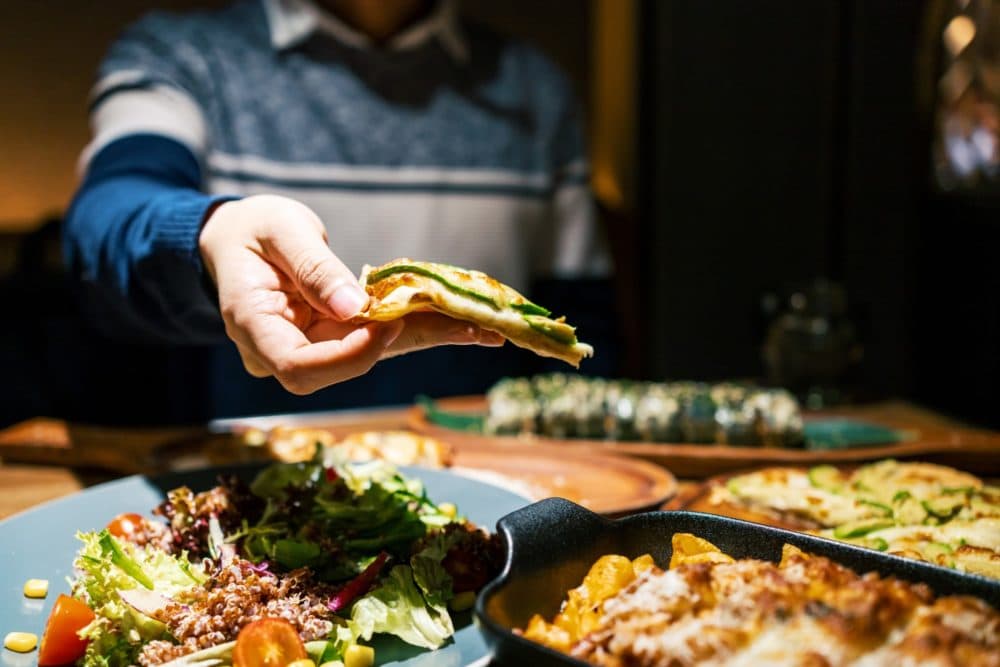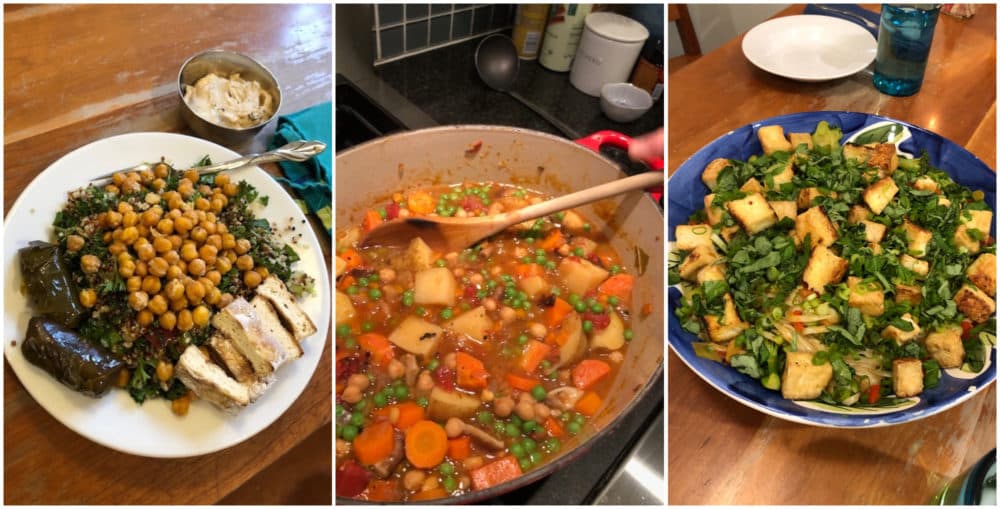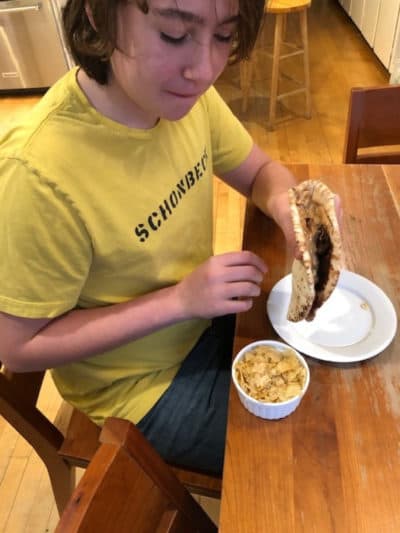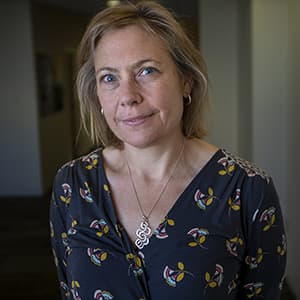Advertisement
Commentary
Eating less meat is better for the planet. Could my family go vegan for a month? Could I?
Resume
One of my son’s favorite recipes is “dinner en papillote” — it sounds fancy but it’s just sausage, potatoes, onions and mushrooms, wrapped in aluminum foil and baked for an hour.
Voila — dinner is served!
I expected the vegan version would be a hit. The soy chorizo looked just like regular chorizo, and everything else was the same. I served it with a flourish, pleased with myself. Hugh, age 12, looked at the sausage and sighed, poked at it gloomily, then took a bite.
“It tastes kinda weird,” he said.
My other son, Finn, age 14, was more direct: “That’s not chorizo, and I know chorizo,” he said. “Why are we doing this?”
“It’s just better,” I said. “For you, us — the planet.”
“You think that’s better for the planet?” he asked, pointing at the fake meat. “It’s probably not.”
And honestly, I was starting to wonder.
I had undertaken Vegan January as research. I’m an environmental reporter at WBUR, and was working on a project about sustainable eating in New England. Everything I had read said that a vegan diet was better for the planet: lower greenhouse gas emissions, less water use and obviously nicer to animals than the standard American diet.
The first week was a steep learning curve. Or maybe it was a learning cliff? Because I fell into some kind of newbie vegan hell.
And look, I know climate change isn’t your fault, and it’s not on you to fix it. But last summer, when the United Nations delivered its latest report on climate change, I spent a day reading and then an hour staring out the window, overwhelmed. The world has until 2050 to get to net-zero carbon emissions, and we’re not even close. But there is still a thin sliver of hope that we might avoid the worst effects of climate change, if we each do everything we can.
And study after study says that one thing we can do is eat less meat.
But a vegan diet seemed difficult, potentially expensive, and also — as my son said — "kinda weird." So, I figured I’d try it out for myself — “gonzo journalism, but with lentils!” said a friend. If nothing else, I’d learn some new recipes and finally figure out tofu. And, it would be a family adventure!
My kids didn’t see it that way. They are in middle school and blessedly unconcerned with planetary crises, so the climate benefits of a vegan diet were not a big selling point. When I sprung the idea on them, Finn stormed out of the room and Hugh sat on the couch looking glum. “But I like meat,” he said in a quivery voice. “I like eating animal products.”

The kid does really does like meat — he wrote an ode to Shake Shack for his school poetry unit.
“Only for a month!” I said. “It’ll be fun!”
Shopping was fun, anyway. I bought all kinds of vegan stuff: nutritional yeast, which supposedly tastes like Parmesan cheese; flaxseed, which you can use in place of eggs; liquid aminos, not exactly sure what those are for; and coffee creamer made from coconut, algae and mushrooms.
The first week was a steep learning curve. Or maybe it was a learning cliff? Because I fell into some kind of newbie vegan hell. I made red curry noodles with broccoli and tofu, which looked great but was greasy and gummy. I made tacos with vegan cheese, which Finn said tasted like “shreds of rubber, coated in Cheeto dust.” I made vegetable stew, and the kids threw shade. “It tastes like chicken soup but someone else got all the chicken and we got left with the vegetables,” said Hugh.

Finn got revenge by making himself a “peanut-butter-cup taco” for lunch: pita bread heaped with peanut butter and Nutella, then folded in half. With potato chips. “Look, I’m vegan!” he said cheerfully.
I woke up every morning starving, with a pounding headache.
By the first weekend, I couldn’t take any more ... of my sons’ complaining. I let them quit being vegan and forged ahead on my own.
With the kids off my back, I found some equilibrium. I introduced protein shakes and the headaches went away. But I didn’t feel great about chugging super-processed protein powder, or about vegan food in general. A lot of it was high-calorie, expensive and ultra-processed, with dubious nutritional value. One day I found myself looking longingly at a can of tuna in the cupboard. Twenty-seven grams of protein, in such a small container! So cheap and easy!
I bought myself some “toona” made of pea protein. It smelled like rancid cat food.
This was not my first weird food rodeo. About 15 years ago I was diagnosed with celiac disease and had to stop eating wheat. That was before “gluten-free” was popular, and there were few products I could buy, mostly high-sugar, high-calorie and super-processed. Eventually, I stopped eating that stuff, and stuck with things that naturally had no wheat — rice, corn, potatoes, lentils, fruits and vegetables. You know, food.
That’s what finally worked for me in Vegan Land. Actual food. I ditched the "chick’n" and "toona" and made polenta, quinoa salad and bean soup. I ate salads with avocado. I embraced chickpeas. I roasted them, learned how to make falafel, and discovered the miracle of aquafaba — the gummy chickpea water that whips up like egg whites. I made it into a chocolate mousse and the kids gobbled it down.
Once I started cooking actual food, eating vegan became pretty cheap and easy. And I didn’t miss meat at all.
That’s what finally worked for me in Vegan Land. Actual food.
But I sure missed fish, and real cheese.
At the end of January, I stopped being vegan. But the experiment changed the way I eat. I haven’t eaten much beef or pork since then — I’ve lost the taste for it. Polenta, falafel, and quinoa have stayed on the menu, and I’ve become a chickpea evangelist.
The nutritional yeast and liquid aminos remain unopened.
The other day my husband asked if he could throw them away. I almost said yes, but then stopped myself. My search for sustainable eats isn’t over. I’m still working on how I should eat to do my part for the planet while keeping fun in food and peace in the house. So I said: Don’t throw them away yet. I don’t think I’m done.
